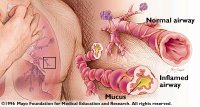People who suffer from asthma can't realistically close themselves off from the rest of the world during cold and flu season. But they do need to take special precautions. Colds and flu are common asthma triggers. In fact, asthmatics often wheeze and experience tightness in the chest a day or so after catching a cold.
Asthma is a chronic inflammation of the lung's airway tissues affecting an estimated 20 million Americans, including 9 million children. The lungs are inflamed even when symptoms are not present.

This inflammation makes the airways even more sensitive to allergens, which are substances your body mistakenly perceives to be a threat.
However, attacks can occur when the body overreacts to true threats - such as the viruses that cause colds and flu. During an attack, the airways tighten and fill with mucus. This traps air within the lungs, which the body cannot expel. The wheezing characteristic of an asthma attack is actually the body trying to force air out of the lungs. Viruses can also replicate themselves more quickly within inflamed lungs, leading to further inflammation and more severe asthma attacks.
To minimize the likelihood cold and flu season infections, take the following precautions:
• Obtain an annual flu shot
• Wash hands frequently or use hand sanitizer
• Do not share glasses, utensils and other items with those who are sick
Cold and flu viruses are spread through airborne droplets from coughing and sneezing and by touching surfaces contaminated with the germs. Asthmatics should try to avoid close contact with people who have colds or the flu. This may be difficult, especially if it is your spouse or young son or daughter.
At work, use disinfectant wipes or spray daily to clean the surfaces of commonly used items, such as telephone handsets and buttons, computer keyboards and other accessories, the copier and fax machine buttons, file cabinet draw handles, the office refrigerator door and light switches.
At school, pack a small package of disinfectant wipes in your child's backpack and instruct on him or her on how to wipe their hands and desktops during the day. Schools and day care centers and notorious germ incubators and many of them may already have sanitization measures in place. If your child has asthma, let school officials know so teachers can be alert to signs of an attack.
At home, the same regimen of disinfecting will help prevent the spread of viruses and germs, especially if a loved one or roommate already has a cold. Viruses and other germs can live on the surfaces of handrails, door handles and other objects for up to two hours. You become vulnerable to infection when you touch those surfaces and then rub your eyes, nose or mouth. Not everyone will get sick because we all have different immune systems and some are better able to fight off cold and flu bugs.
There is no way to completely prevent the occurrence of a cold. However, it is extremely important to avoid exposure to cold germs during the first few days after a person becomes infected, when the condition is particularly contagious.
If you have asthma and you catch the flu, your doctor may recommend antiviral medications. These drugs may lessen symptoms if taken within one to two days of exposure. Pay attention to your symptoms, drink lots of fluids and monitor your breathing. A peak flow monitor will tell you how well your lungs are functioning. Keep track of the results by taking readings at the same time each day, and call your doctor if there is a drop in your peak flow rate.
Finally, a good formula for staying healthy through the winter months includes eating a healthy, balanced diet. Fresh fruit and vegetables, regular exercise and a good night's sleep will help boost your immune system to fight off whatever the cold and flu season sends your way.

















